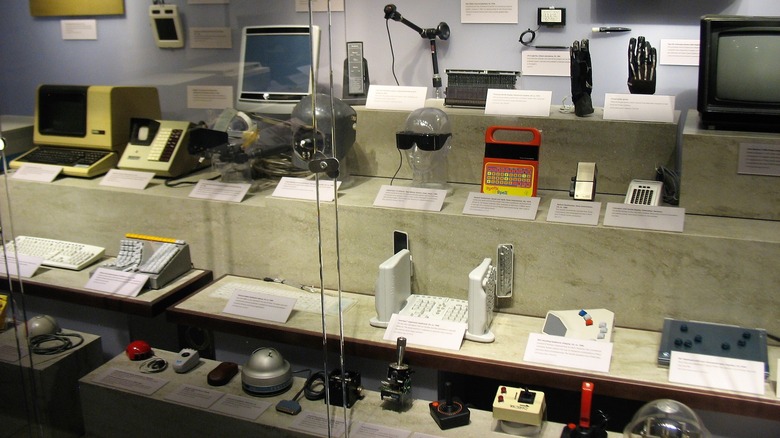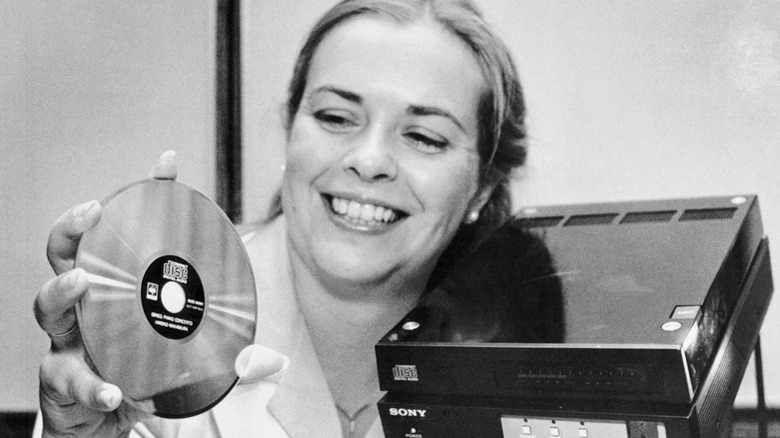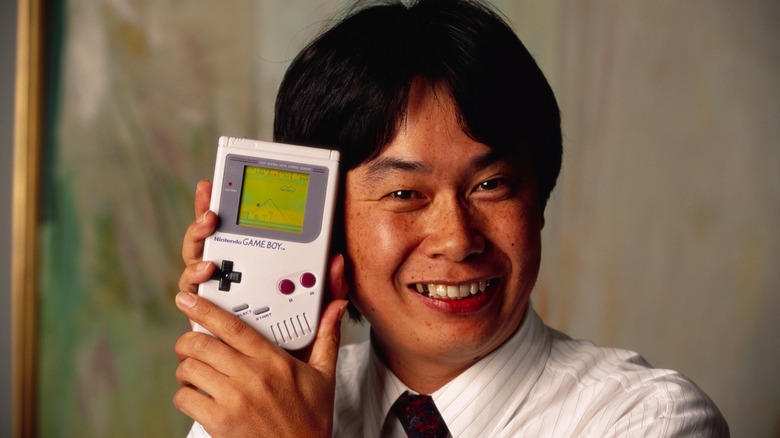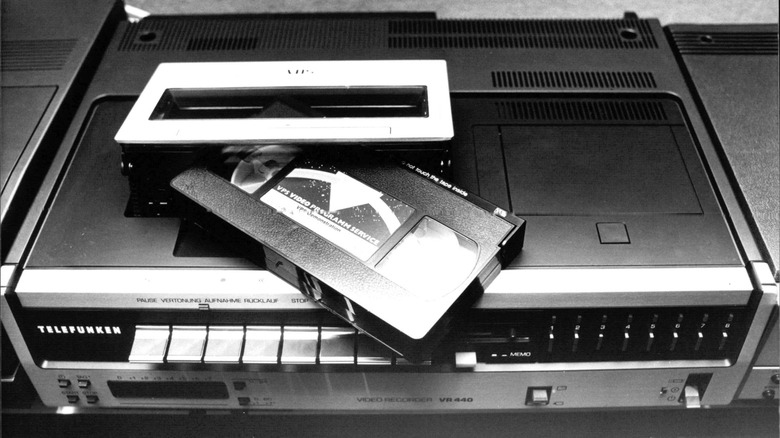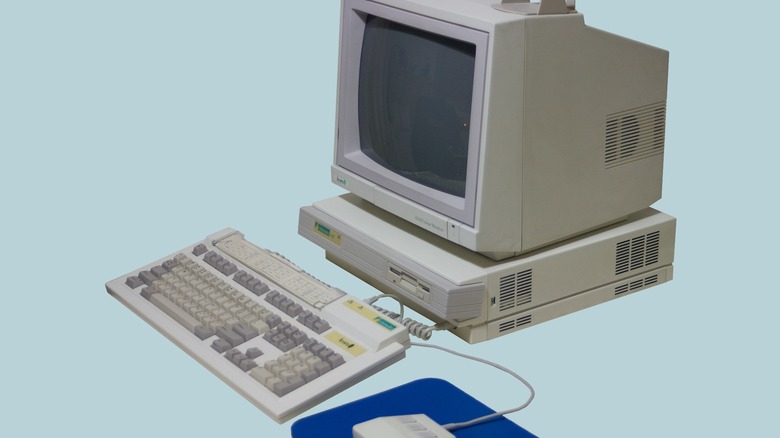6 Gadgets From The '80s That Shaped Modern Tech
We may receive a commission on purchases made from links.
The 1980s were a time of significant change in the tech world. The personal computer industry exploded with numerous manufacturers warring with each other while offering little in the way of interoperability. Video games were booming both in arcades and at home until consoles declined steeply in 1983, only for Nintendo to revive the industry in 1985 with its NES console and revolutionize portable entertainment with the release of the portable handheld Game Boy console in 1989.
Portability also played a role in how the music industry changed, with cassettes and compact discs overtaking vinyl records as the decade went on, thanks in part to being easy to listen to on the go. It also helped that CDs didn't have audible background noise that wasn't present on the master tape. Portable video hadn't matured yet, but on-demand viewing had, as the '80s were when videotape became sufficiently viable for home use. This allowed for recording of TV shows and on-demand viewing of both those and pre-recorded videotapes available for rent and sale.
Even what we would come to refer to as home automation or smart home products started to really come into focus in the '80s thanks to the popularity of The Clapper, which was basically an offline, sound-activated version of today's smart plugs. And the sneakily efficient yet powerful ARM CPUs that power all sorts of modern computing devices? Those emerged in the '80s, too. Let's look at some of the '80s gadgets that shaped tech as we know it.
Sony Walkman
Today, portable audio players are a fact of life, usually via software installed on the smartphones that we take with us everywhere. Walk around any neighborhood in any major city in any industrialized nation, and you'll surely see plenty of people walking around with headphones on, listening to music, audiobooks, and podcasts. In the 1970s, life was certainly not like that. Listening to recorded music was mainly an activity you did at home using vinyl records, ideally on a really nice turntable as part of a hi-fi stereo system. Transistor radios had been around since 1954, providing some portability, but if you wanted to listen to your favorite music on the go in relatively high quality, there wasn't anything worthwhile.
That changed in 1979, when Sony released the first Walkman, a portable player for compact cassettes, which were the highest quality portable music format to date. Cassettes had launched alongside 8-Track cartridges, another more portable format, in the 1960s, but were not considered a format of particularly good fidelity until significant improvements were made to cassette technology in the 1970s. Once cassettes lapped 8-Track, Sony swooped in, capitalizing on their growing popularity with the Walkman. In the years after its launch, Sony made the Walkman smaller and lighter to enhance its portability, paving the way for it to become one of the biggest product lines in Sony history, selling roughly 200 million units from 1979 through its 2010 retirement.
Compact Discs and CD Players
At the start of the 1980s, pre-recorded music was available solely in the analog domain, with vinyl records and compact cassette tapes being the dominant formats. Each format had its pros and cons: Vinyl, handled correctly, was the best-sounding consumer format, but it wasn't portable, records were (and still are) distressingly easy to damage, and the end-user couldn't record their own audio to it. Cassettes were ultraportable, recordable, and more difficult to damage, but were also noticeably lower fidelity than vinyl. There needed to be something that combined the best of both worlds as much as possible, and compact discs provided that when they launched in 1982. However, they couldn't be recorded on.
At launch, the tagline for CDs was "perfect sound forever," pointing to how the digital format offered startlingly clear sound without the noise inherent to analog formats more broadly or the relative brittleness of vinyl. This was very appealing to the average consumer, to the point that, by the end of 1988, CDs were outselling vinyl, eventually also passing cassettes in 1991. However, the music industry going all-in on digital came with a side effect that wouldn't manifest for a while: CD-ROM drives became standard in personal computers, they could read and extract music CD data, and, by the late '90s, advances in compression and broadband internet availability made it trivial to rip and share music in surprisingly high quality. This unauthorized sharing pushed the industry to the current norms of music streaming and downloads.
Nintendo Game Boy
For much of the 1980s, portable electronic entertainment options were limited. Cassettes and CDs had greatly increased the portability of recorded music, and if you were feeling really spendy or adventurous, there were handheld TVs like the Sony Watchman, but that was about it. At the same time, home video games ebbed and flowed, with the industry crashing in the United States in 1983 due to over-saturation and poor quality control before being revived a few years later by the Nintendo Entertainment system. Throughout the '80s, Nintendo also released various self-contained Game and Watch portable games, but they were extremely primitive relative to what was available at home, and this needed to change.
Enter the Game Boy, a portable system with a monochromatic screen that retailed for $109 when it launched in late 1989. The screen wasn't lit, either, but these concessions were necessary to get what Nintendo rated as 30 hours of gameplay out of four AA batteries at a time when rechargeable battery technology was still pretty immature. It might not have seemed like a lot at the time, but when the Game Boy's color rivals couldn't come close to comparable battery life, it became a massive advantage for Nintendo. Though the larger Game Boy line would sell even more, the monochromatic models would end up selling more than 64 million consoles worldwide, changing portable gaming forever. Competitors would come and go, but Nintendo has never really stopped dominating the handheld video market since.
The Clapper
In theory, home automation is pretty new, only catching on in a big way in recent years thanks to a significant push by the tech industry and unified via standards set by big players like Google, Amazon, and Apple. Some features of the smart home and are pretty trivial, overpriced, and not of much utility for the average person, like smart refrigerators, but the smart home concept goes way beyond that.
You can spend $20-$30 and get a set of lightbulbs or smart plugs that let you use your phone and other internet-connected devices to control your lights and, specific to smart plugs, anything with a simple on/off state. Though the current state of the art is a lot more advanced, an offline version of the smart plug has existed for decades: The Clapper, a sound-triggered plug that was all over TV during the 1980s.
Still available from major retailers like Amazon, The Clapper is pretty simple: It lets you turn a lamp, desk fan, etc. on and off by clapping your hands in a specific rhythm. It was a bit primitive at first, sensitive to too many different kinds of sounds, before it was tweaked into the Smart Clapper in 1987. That revision, which serves as the basis for the modern version of the product, improved the detection accuracy. If you hate using your phone for remote light toggling, it's still a viable option.
VHS (and Betamax) VCRs
For the first few decades of television, if you missed a program, you were unlikely to ever see it again unless it was a sitcom, drama, or talk show in reruns. Videotape was the incredibly-expensive domain of professionals, with the dominant formats being reel-to-reel systems with playback hardware was the size of a refrigerator. As the 1970s started, there were advances on the professional side, with Sony's cassette-based U-Matic format being the most convenient yet, but at home, videotape wasn't viable yet.
That changed with the 1975 launch of Sony's Betamax format and JVC's VHS following in 1976, which finally brought video cassette recorders into the home. It took time to build a user base, but by the end of 1985, 28% of American homes had a VCR and VHS overtook Betamax, with consumers preferring VHS tapes' much longer recording times to Betamax's somewhat better picture quality.
Now? You could not just record TV shows or any other signal they could feed into a TV, but also play pre-recorded movies, both of which revolutionized how we interface with home entertainment. Between both options, you could watch what you wanted on your schedule, and it was refreshing. Hollywood balked at the recording functionality, though, with MCA/Universal and Disney suing Sony in 1976, alleging copyright infringement. The case dragged out until reaching the U.S. Supreme Court in 1985, where time-shifting TV shows were affirmed as fair use, creating precedent that underpins modern copyright law as we know it.
Acorn Archimedes computer
The personal computer world was incredibly fractured in the 1980s, with numerous, usually non-compatible options of all shapes, sizes, and power levels available from companies like IBM, Apple, Atari, Tandy, Acorn, Commodore, and Sinclair. A bunch of those computers were influential in various ways that would warrant making it onto a list like this, especially the IBM PC and Apple Macintosh for how the product lines still live on. However, there's a real argument that the most wide-reaching influence, at least in terms of touching the most lives via the most devices, came from one of the smaller companies, Acorn. That's because the British company, as a follow-up to the government-backed BBC Micro computer, released the Archimedes in 1987, and it featured a new type of processor architecture: the Acorn RISC Machine, or as we now know it, ARM.
In time, ARM's popularity would explode thanks to its low power consumption. It would be impossible to name everything powered by ARM, but hopefully these examples give a good idea of how widely it's used. Virtually all smartphones of note, regardless of manufacturer or operating system, are powered by ARM. Nintendo's handheld video game consoles since the Game Boy Advance have all been ARM-based, including the DS family and the Switch. The architecture's performance to power ratio has improved so much that Apple shifted its Mac computer line to ARM in 2020 to rave reviews. This just scratches the surface: ARM's everywhere, and it goes back to the Archimedes.
[Featured image by PaulVernon1974 via Wikimedia Commons | Cropped | CC0 1.0 Universal]
